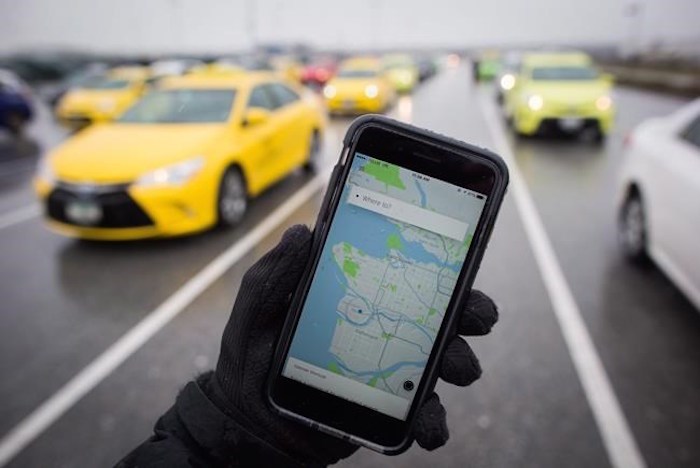App-based ride-hailing services will address shortcomings of B.C.’s taxi industry identified by the public and through government investigations, according to a recent Passenger Transportation Board report.
Whether that is true or not has been an issue of great debate for several years.
But, said board chair Catharine Read, ‚Äúthere has been enough work done that demonstrates the need for ride hailing.‚ÄĚ
 The Uber app is displayed on an iPhone as taxi drivers wait for passengers at ¬ť∂Ļīę√Ĺ”≥Ľ≠International Airport, in Richmond, B.C., on Tuesday March 7, 2017. The federal Competition Bureau wants British Columbia to re-examine its taxi regulations to permit more competition in the industry and improve services for riders and businesses. THE CANADIAN PRESS/Darryl Dyck
The Uber app is displayed on an iPhone as taxi drivers wait for passengers at ¬ť∂Ļīę√Ĺ”≥Ľ≠International Airport, in Richmond, B.C., on Tuesday March 7, 2017. The federal Competition Bureau wants British Columbia to re-examine its taxi regulations to permit more competition in the industry and improve services for riders and businesses. THE CANADIAN PRESS/Darryl Dyck
She said regulations for ride hailing should be forthcoming from the government soon.
Three smartphone app-based companies ‚ÄĒ Kater, Uber and Lyft ‚ÄĒ are vying for a foothold in the Lower Mainland market, one of the few large cities in North America without such a service.
Uber and Lyft can’t operate under current rules due to insurance issues, which could prevent the Passenger Transportation Board from approving services.
Two more services, Saskatchewan-based Oye.One and RypeRides, have also been involved in direct discussions with Victoria.
The B.C. government tabled legislation in Nov. 19, 2018, to introduce insurance products for ride-hailing companies by fall 2019. If passed, the legislation would require ride-hailing drivers to have a commercial or Class 4 driver’s licence, and would need to pass criminal record, medical, security and safety checks.
The board said in a June 21 report that the need for ride hailing has been demonstrated through two rounds of Select Standing Committee on Crown Corporations hearings and a 2018 report entitled, Transportation Network Companies in British Columbia; consultant Dan Hara’s report, Modernizing Taxi Regulation, which was produced after wide stakeholder consultation; extensive media coverage; and Legislature debates.
‚ÄúThe debates demonstrate that ride hailing is supported by all three parties in the Legislative Assembly, although there are differences in how they would implement ride hailing,‚ÄĚ the report said.
And, the report said, illegal ride sharing already exists in Metro Vancouver. But, while there have been enforcement activities, violation fines have not been sufficient to stop the illegal services and the demand for it.
‚ÄúThe ongoing operation of illegal ride hailing in Metro Vancouver, despite efforts of enforcement staff to curtail this, supports the view that consumers desire greater choice in vehicles-for-hire,‚ÄĚ the report said.
Read agreed with that assessment.
The document said Hara found the issue was one of supply, an issue best measured by wait times during peak taxi demand periods.
‚ÄúTypically, there is an oversupply of taxis at non-peak periods and a shortage at peak periods,‚ÄĚ the report said. ‚ÄúWithin the last year in Vancouver, numerous media reports have chronicled lengthy wait times at bar closures on weekend nights, at the ¬ť∂Ļīę√Ĺ”≥Ľ≠International Airport, after special events and when cruise ships arrive.‚ÄĚ These corroborate Dr. Hara‚Äôs findings of inadequate supply of vehicles-for-hire at peak periods.‚ÄĚ
Demand also varies by time periods.
The report said ride hailing addresses those issues by increasing the supply of vehicles-for-hire in peak periods and reducing supply in off-peak periods.
The board said Dr. Garland Chow found that peak demand in Vancouver’s Downtown Entertainment District on Saturday and Sunday evenings between 2 and 3 a.m. is about six times greater than demand for any hour between 10 p.m. and 1 a.m. on weekends.
Or, as the Hara report said, ‚ÄúA fixed number of taxis is arbitrary. More taxis are needed on Friday night than at 10 a.m. on weekdays. The fixed number is usually somewhere in between.‚ÄĚ
Read said the app will allow for setting of rates. When demand is low, prices will fall and fewer cars would be on the road. When demand increases, rising fares would attract more drivers to meet demand, she explained.
The report also discussed taxi service quality and the lack of good data.
It said of 239 taxi complaints received by Consumer Protection BC in the past eight months, about 90% related to service in the Greater ¬ť∂Ļīę√Ĺ”≥Ľ≠Regional District.
The most common complaints were:
- Driver behaviour and unsafe stopping (40%);
- Trip refusal (33%);
- Wait times, taxi not arrived (11%); and
- Rates - rates not per meter, meter not used, excessive deposits, extra charges (11%).
Ride hailing addresses service concerns with the ability to use service apps so consumers have a direct role in ensuring service quality.
‚ÄúDrivers are rated by their customers for each trip and, with some companies, drivers are required to maintain a certain rating level to remain on the platform,‚ÄĚ the report said. ‚ÄúPassenger ratings of each trip will influence driving behaviour, which is the major complaint against taxi drivers.‚ÄĚ
Price was also an overriding issue in that taxi users have no choice on rates, the report said.
‚ÄúTaxis provide a service at rates that do not vary as demand for the service increases or falls,‚ÄĚ it said. ‚ÄúThere are consumers who would be willing to pay more for better service in peak periods. Other consumers would use vehicle-for-hire service more often if lower prices were offered for off-peak periods.‚ÄĚ
With ride hailing, the report said, prices would vary between demand periods. ‚ÄúThe apps provide fare information prior to a customer and driver embarking on a fare, indicating that the cost of the trip is acceptable to both parties.‚ÄĚ
Neither BC Taxi Association president Mohan Kang or the ¬ť∂Ļīę√Ĺ”≥Ľ≠Taxi Association‚Äôs Carolyn Bauer could be reached for comment.


